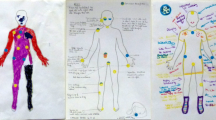Abstract
This paper argues that the current involvement of end users in the design of technological artefacts is too superficial. It is common to involve people in requirements generation, but rarely in product inception or design. A study is reported involving five households in central Scotland, who were each visited on three occasions, using a new investigative framework. Illustrative examples are provided of the strengths and weaknesses of the methods used. Despite the latter, it is demonstrated that the general public can both generate and critique design ideas and that valuable contributions to understanding people's relationships with technologies can be expected both from children and from the elderly.




Similar content being viewed by others
Explore related subjects
Discover the latest articles, news and stories from top researchers in related subjects.References
Atkinson JM, Heritage J (1984) Structures of social action: studies in conversation analysis. Cambridge University Press, Cambridge, UK
Benford S, Bederson B, Akesson K, Bayon V, Druin D, Hansson P, Hourcade J, Ingram R, Neale H, O'Malley C, Simsarian K, Stanton D, Sundblad Y, Taxen G (2000) Designing storytelling technologies to encourage collaboration between young children. In: Proceedings of CHI2000, The Hague, Netherlands
Bødker S, Ehn P, Sjogren D, Sundblad Y (2000) Co-operative design: perspectives on 20 years with 'the Scandinavian IT design model'. In: Proceedings of NordCHI 2000. STIMDI, Stockholm, pp 1–9
Brown JS, Duguid ACP (1996) Organizational learning and communities of practice: toward a unified view of working, learning and innovation. In: Cohen MD, Sproull LS (eds) Organizational learning. Sage, London, pp 58–82
Buur J, Bødker S (2000) From usability lab to 'design collaboratorium': reframing usability practice. In: DIS 2000, conference proceedings on designing interactive systems: processes, practices, methods, and techniques. ACM, New York, pp 297–307
Carroll JM (1995) The scenario perspective on system development. In: Carroll JM (ed) Scenario-based design: envisioning work and technology in system development. Wiley, New York, pp 1–17
Carroll JM (1997) Human–computer interaction: psychology as a science of design. Int J Hum–Comput Stud 46(4):501–522
Druin A (1999) Cooperative inquiry: developing new technologies for children with children. In: CHI'99. ACM Press, New York, pp 592–599
Fetterman DM (1989) Ethnography step by step. Applied social research methods series, vol 17. Sage, London, p 73
Gaver W, Dunne T, Pacenti E (1999) Cultural probes. Interactions of the ACM, New York, pp 21–29
Jungk R, Mullert N (1987) Future workshops: how to create desirable futures. Institute for Social Inventions, London
Kjaer A, Madsen KH, Petersen MG (2000) Methodological challenges in the study of technology use at home. In: Sloane A, van Rijn F (eds) Home informatics and telematics: information technology and society. Kluwer, Boston, pp 45–60
Mateas M, Salvador T, Scholtz J, Sorenson D (1996) Engineering ethnography in the home. In: Proceedings of CHI'96. ACM, Vancouver, pp 283–284
O'Brien J, Rodden T (1997) Interactive systems in domestic environments. In: Proceedings of DIS'97: designing interactive systems: processes, practices, methods, and techniques. ACM, Amsterdam, pp 247–259
O'Brien J, Rodden T, Rouncefield M, Hughes J (1999) At home with the technology: an ethnographic study of a set-top-box trial. ACM Trans Comput–Hum Interact 6(3):282–308
Sarela-Oksanen K (2000) Invisible technologies, invisible boundaries? In: IFIP W.G. 9.3: home-oriented informatics and telematics (HOIT) international working conference, pp 161–168
Venkatesh A (1996) Computers and other interactive technologies for the home. ACM 39(12):47–54
Venkatesh A (1999) New information technologies in the home: a study of uses, impacts and design strategies. In: ECRD environmental design and research conference, Orlando, FL, 2–6 June 1999
Acknowledgments
We wish to thank Dr Alison Crerar for her helpful comments on previous versions of this.
Author information
Authors and Affiliations
Corresponding author
Rights and permissions
About this article
Cite this article
Baillie, L., Benyon, D., Macaulay, C. et al. Investigating design issues in household environments. Cogn Tech Work 5, 33–43 (2003). https://doi.org/10.1007/s10111-002-0116-5
Received:
Accepted:
Published:
Issue Date:
DOI: https://doi.org/10.1007/s10111-002-0116-5




